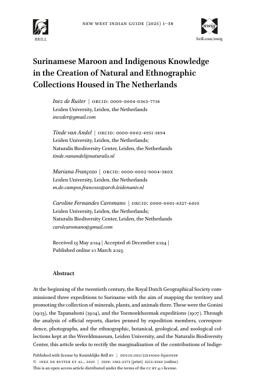2025-03-10
Surinamese Maroon and Indigenous Knowledge in the Creation of Natural and Ethnographic Collections Housed in The Netherlands
Publication
Publication
New West Indian Guide / Nieuwe West-Indische Gids , Volume 2025
At the beginning of the twentieth century, the Royal Dutch Geographical Society commissioned three expeditions to Suriname with the aim of mapping the territory and promoting the collection of minerals, plants, and animals there. These were the Gonini (1903), the Tapanahoni (1904), and the Toemoekhoemak expeditions (1907). Through the analysis of official reports, diaries penned by expedition members, correspondence, photographs, and the ethnographic, botanical, geological, and zoological collections kept at the Wereldmuseum, Leiden University, and the Naturalis Biodiversity Center, this article seeks to rectify the marginalization of the contributions of Indigenous and Maroon laborers to the success of these expeditions in Suriname, challenging traditional narratives of exploration and “discovery.” Our research illustrates how local communities were instrumental in curating the collections currently housed at the Wereldmuseum and the Naturalis Biodiversity Center in the Netherlands, underscoring the significance of acknowledging the invaluable contributions of non-European individuals in the annals of Western science.
| Additional Metadata | |
|---|---|
| , , , , , | |
| doi.org/10.1163/22134360-bja10038 | |
| New West Indian Guide / Nieuwe West-Indische Gids | |
| Released under the CC-BY 4.0 ("Attribution 4.0 International") License | |
| Organisation | Staff publications |
|
de Ruiter, Inez, van Andel, T., Françozo, Mariana, & Fernandes Caromano, C. (2025). Surinamese Maroon and Indigenous Knowledge in the Creation of Natural and Ethnographic Collections Housed in The Netherlands. New West Indian Guide / Nieuwe West-Indische Gids, 2025. doi:10.1163/22134360-bja10038 |
|
